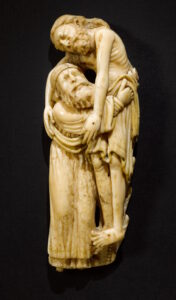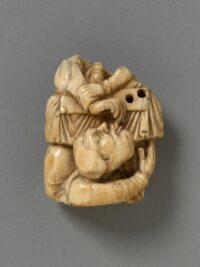The Financial Times has a report about the attempt to raise £2million to keep an ivory carving of the Deposition of Christ from the Cross in the country. The carving was originally part of a larger scene, and arguably part of a triptych or five fold reredos, and is ascribed to a York workshop of the 1190s. As such it is a precious survival of a school or tradition of which we now have so little.
 The article then goes on to look at British regulations regarding art exports, and compares them with those in France, Germany, and Italy about safeguarding heritage objects and preventing their loss overseas.
The article then goes on to look at British regulations regarding art exports, and compares them with those in France, Germany, and Italy about safeguarding heritage objects and preventing their loss overseas.The Financial Times article can be seen at Battle to keep sculpture in Britain highlights European museums’ struggles
The Government website covers the legal case at Walrus ivory carving of Deposition from the Cross at risk of leaving the UK
The Museums+Heritage Advisor website describes the story at V&A looks to acquire 12th-century ivory carving for £2m as does ArtNet at The U.K. Is Barring the Export of a Rare Medieval Statue Acquired by the Met. Will the V&A Snap It Up
The History Blog also reported on the carving in Met acquires rare Romanesque Walrus ivory carving; UK bars export
However when I was looking further into the story to write this article I was absolutely fascinated to find that the carving has a very close link to my home area. That was certainly not well known when I lived in the area, and indeed unknown to me.
The other surviving fragment, of Judas eating the morsel at the Last Supper, from the reredos was found in Wakefield in 1769 and is now in the V&A. It can be seen to have survived through deliberate moves to secret religious art in the town in the mid-sixteenth century. Where the reredos was before that terrible time of tragedy is unclear - possibilities include the parish church - since 1888 the Anglican cathedral - or the castle at Sandal just south of the town, the Hospitaller Preceptory at Newland to the east, or even one of the four chantry chapels that were on the main roads into the town. Another possibility, if less likely, might be that it came from a church
further afield.
The historical background is set out in excellent detail by Apollo at The V&A is by far the best home for this medieval sculpture and by the Independent at The story of the walrus and the English artwork at risk of being sent to the US
There is another article with valuable insights from the magazine Artdependence at V&A launches Fundraising Campaign to acquire Rare 12th-century Medieval Walrus Ivory Carving
Given that connection to where I was born and raised, and formed as both a historian and as a man of Catholic belief I obviously hope very much that the money can be found to keep this exquisite carving here, with the other fragment - one would not wish it to suffer the exile in the Met that has been the fate of the Bury St Edmunds Cross.
Images: The History Blog



No comments:
Post a Comment